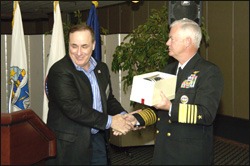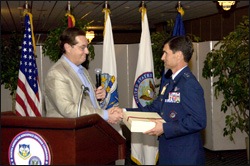U.S. Northern Command to Take Larger Role in Disaster Relief
The United States Northern Command (NORTHCOM), the newest of America’s regional combatant commands, may not be a household name but, as a JINSA delegation learned during a recent visit, it plays a critical role in defending the American homeland from attack whether by terrorists, long-range missiles or natural disasters.

The United States Northern Command (NORTHCOM), the newest of America’s regional combatant commands, may not be a household name but, as a JINSA delegation learned during a recent visit, it plays a critical role in defending the American homeland from attack whether by terrorists, long-range missiles or natural disasters.

Just two weeks ago, Air Force Space Command satellites detected the test launches of six North Korean ballistic missiles and fed the launch information in real-time to operators at USNORTHCOM. Had those missiles posed a threat to the U.S. or its territories, NORTHCOM would have had the primary responsibility in defending the nation using ground-based interceptors located at Vandenberg AFB, Calif., and Fort Greely, Alaska. And last fall’s series of devastating hurricanes cruelly demonstrated the need for greater coordination and synchronization between civilian first responders, the National Guard and the federal government and the active duty armed forces. The head of U.S. Northern Command, Admiral Timothy J. Keating, USN, said that the role of active-duty military personnel could be broadened to help fill gaps in local and state-level disaster response. Defense Secretary Donald H. Rumsfeld echoed Keating’s comments after he visited the command at its headquarters at Peterson Air Force Base in Colorado Springs, Colorado.
A JINSA leadership delegation comprised of 21 people returned from NORTHCOM headquarters after a series of briefings similar to what Secretary Rumsfeld received. NORTHCOM’s Policy and Planning Director, Air Force Maj. Gen. Mark A. Volcheff, hosted the JINSA group, which also spent time with Adm. Keating. JINSA Board of Advisors member Maj. Gen. Robert Patterson, USAF (ret.) escorted the delegation.
NORTHCOM: Forged Out of 9-11 Attacks
The need to consolidate U.S. military assets to defend the American homeland was made clear on September 11, 2001. U.S. Northern Command was officially established on October 1, 2002. Active not just against terrorist threats to the mainland, NORTHCOM serves an increasingly important role in coordinating the U.S. active duty armed forces response to natural disasters once requested by the lead federal agency and directed by the President or Secretary of Defense. The command leverages the tremendous personnel and materiel assets from the various services at stateside locations to assist the civilian-led response to a major disaster.
In anticipation of the North Korean action, NORAD’s Cheyenne Mountain Operations Center, was also on alert. Cheyenne Mountain, toured by the JINSA group, serves as a secure site for the coordination and communication of American military response to threats to North America. NORAD, portrayed in numerous Cold War-era thrillers, is the North American Aerospace Defense Command, established in 1958 to unite Canadian and U.S. forces in defending their common air space (delete “from Soviet incursion”). It is a truly bi-national command where Americans and Canadians serve side-by-side. NORAD’s deputy commander is always a Canadian officer, currently Lt. Gen. Eric A. “Rick” Findley.
Canada, too, has changed in the wake of 9-11. Our northern neighbor recently created a new military command responsible for all of Canada’s routine and contingency domestic operations. It is called Canada Command and, officials said, is based on the new international security environment and a commitment to place greater emphasis on the defense of Canada and North America. The officer in charge of Canada Command, Lt. Gen. Marc Dumais, is now the second most powerful uniformed officer in the Canadian Forces, reporting directly to the chief of defense staff. Gen. Dumais visited NORTHCOM in early July where he stressed the importance of being prepared to deal with an “event of magnitude” that crosses the U.S.-Canada border in an effective binational and bilateral way. The relationship between the two commands will enhance support between the nations during events like Hurricane Katrina last year in the United States and the 1998 Canadian ice storm, he added.
Supporting Disaster Preparedness and Recovery
Coordination and communication between various agencies responding to disasters was an issue of great concern in the aftermath of Hurricane Katrina. Serious discussions have produced an understanding between the National Guard and Northern Command about how each will respond to a disaster, JINSA leaders were told.

“The kinds of capabilities the Department of Defense is able to bring to problems are unique and distinctive, and we are part of a complicated network of responders,” Rumsfeld announced after his visit. The JINSA delegation learned that the Pentagon acts only in a support role assisting first responders – state and local governments, and if necessary, the Department of Homeland Security – once the Primary Federal Agency assumes lead responsibility in a disaster.
Admiral Keating told JINSA that civilian agencies and the National Guard should retain their lead role in responding to disasters. He advised that those agencies take advantage of some of the unique capabilities of active-duty troops during disasters on the scale of Hurricane Katrina.
Noting that 17 storms, five considered significant, have been predicted for the 2006 hurricane season, Chief of the National Guard Bureau Lt. Gen. H. Steven Blum said the National Guard knows its role and capabilities. “There will be no command-and-control issues this year,” he said, alluding to problems encountered in responding to Hurricane Katrina last year, adding that his troops would work very closely with NORTHCOM’s active-duty forces. “Our job is to save lives, not waste time arguing about who’s in charge. The governors will be in charge of their National Guards.”
Going further than ever before in hurricane preparedness, Assistant Defense Secretary for Homeland Defense Paul McHale announced earlier this year that Defense Department coordinating officers will be assigned full-time to each of the 10 Federal Emergency Management Agency’s regional offices to ensure coordinated planning and operational integration among the Pentagon, the Department of Homeland Security and FEMA. “Those assets are ready for deployment, and … we are better prepared than at any point in our nation’s history to move that assistance as rapidly as is humanly possible.” In addition, the Pentagon can offer aviation assets capable of providing near-real-time damage assessments, McHale said.
Helping Keep America’s Skies Safe
The events of 9-11 made clear the need for a dedicated military command to also look inward at threats coming from within the U.S. To this end, NORAD tracks civilian aircraft and monitors flight path deviations near restricted airspace. The program is called “Operation Noble Eagle” and has been operating since the day after the 9-11 attacks. Previously, the Federal Aviation Administration (FAA) handled suspicious air activity within the continental United States. Once the FAA determined there was a significant problem, the military would be called in. It took too long. Since then, NORAD is plugged directly in to the Domestic Events Network (DEN). The DEN is a nationwide, open phone line managed by the FAA providing open and improved communications and common situational awareness for Federal agencies with jurisdiction over the security of the U.S. airspace. Participants include the Transportation Security Administration, Department of Defense, FAA and FAA Field Offices, National Capitol Police, Immigration and Customs Enforcement, Secret Service, and the FBI.

It was NORAD personnel who handled the rash of small aircraft that flew over Washington, D.C. in 2005, coordinating the military jets that intercepted these wayward small planes and directed them to nearby airfields where their pilots were questioned. Incursions into the restricted space are common. NORAD briefers told the JINSA group they can expect two or three incursions a day, usually by pilots unfamiliar with the restrictions or who stray from their intended flight paths. Between intercepting wayward pilots and flying patrols over high-risk targets, the U.S. Air Force, and to a lesser degree, the Canadian Air Force, has scrambled or diverted more than 2,100 times and flown more than 42,000 sorties in support of NORAD Operation Noble Eagle missions.
In addition to scrambles and diverts, NORAD also has a Visual Warning System at its disposal, a non-lethal, cost-effective alternatives to scrambling jets. When radio communication with a plane flying into restricted airspace around Washington, D.C. fails, a system of pulsating red and green laser beams is activated. The eye-safe laser beams, which flash red-red-green, are easily seen, even during daylight. In clear conditions, the laser beams can be seen 15 to 20 miles away.
JINSA was also extensively briefed on the Ardent Sentry ’06 U.S. Northern Command exercise that lasted for two weeks in mid May. Designed to test the U.S. armed forces’ ability to support federal, provincial, state and local authorities while carrying out its homeland defense mission, the exercise involved more than 5,000 U.S. and Canadian service members working with local and state authorities in five U.S. states and two Canadian provinces. The test scenario involved simultaneous crises including battling terrorist attacks on the ground, providing military assistance to civil authorities battling an epidemic of a human-to-human transmission of the H5N1 “bird flu” virus and responding to a Category 3 hurricane striking the already devastated southeastern United States.
Air Force Space Command Visited
The JINSA delegation was briefed on the activities of the U.S. Air Force Space Command, also located on the sprawling grounds of Peterson AFB. Comprising some 39,000 personnel split between the 20th Air Force controlling America’s arsenal of land-based Minuteman III intercontinental ballistic missiles, the 14th Air Force responsible for military operations in space including satellite launches and missile warning, and the Air Force Space and Missile Systems Command that is currently staffing nine major program offices. Some of the most exciting developments happening right now in the command involve the “Joint Warfighting Space” (JWS) concept.

The JWS program seeks to provide quick, responsive and dedicated tactical microsatellite communications to commanders in combat. Currently, space support takes entirely too long to come on line after U.S. forces have engaged an enemy force in combat and the satellites are extremely expensive. Modern communications, intelligence programs and weapons guidance are dependent on satellites. Space Command officers also relayed that the relatively inexpensive microsatellites to be used in the JWS program will feature selectable payloads and can be launched into useful orbit quickly.